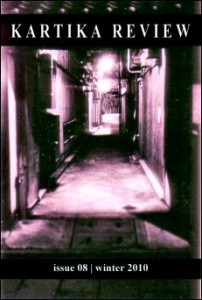 Kartika Review | Issue 8 | Winter 2010
Kartika Review | Issue 8 | Winter 2010
In this emotive issue of Kartika, the primacy of the first person is immediately apparent, and the “I” spotlights the issue’s family theme. Except for one second-person narrated story (which perhaps entreats the reader’s I), all the pieces here are borne from their speakers’ personal narratives. Fiction editor Christina Lee Zilka says her goodbye to the journal by telling a memory of goodbye. Matthew Salesses in “Slowed Time, Normal Time” develops a first-person fiction so deft and sincere it reads like memoir. David Mura’s memoir piece, “My Daughter At 18: Leaving Home,” uses first-person texts as a set of resonances: Mura narrates, and quotes from his daughter’s personal statement for college, in which she quotes not just her past self from a journal but also Mura’s description of her from thirteen years ago—all the I’s of which give an illusory choral effect. Like when you strike a guitar’s middle E and the other E strings hum sympathetically. The issue ends on an email interview with Sumeir Hammad (Woan was right in her editorial to guess, “Like me, you will probably turn to read her interview first”), and Hammad’s insights are given us by a characteristically uncapitalized i.
The two poems of this issue are also told from the first-person, and both pieces are occasions of identity. Rajiv Mohabir’s “holi lovesport stains (krishna-lila)” takes its stylistic theme from the Holi festival tradition of throwing colored powder at one another. From the first, syntactically blurred stanza, disparate bodies are conjoined and selves are multiplied:
we two drunken roses
chests in ruby play swirls
holi in south queens my lover
has many faces i know
Later, “a seven colored bow / across the room // ignited pure joy.” Like the festival’s panoply of colors, the backdrop of the poem is also obscured by imagery and movement. Some themes are more obvious than others. We experience duality in the alternation between left- and right-justified margins in each section. The argot transports us away from a typical American urbanity though the poem is set in South Queens. Lineage and transformation bring us from “the cowlord” to “this cowherd boy,” and “from cow to / my own new name.” The profluence of the poem comes from song and dance, and one of its most musical passages is one of accented vernacular:
abbi been left dat side long time long time
what make you til now na get sense
til when you go sing a-antiman song da
you and he na get none rhyme none rhyme
And it is this type of speech that “churned milky whispers solid / to shame me into diaspora.” In the end we return to colors and the body, “stained,” left with an impression of change.
Peggy Lee’s “Dad” also functions by a panoply of associations, though much less chaotically. The speaker, after twenty years, passes by Chinatown bakery window displays and, through sense-memory, slipstreams back to an adolescence with her father. Nominative details animate the poem: listed food names, food textures, food as desire (“ducks . . . swooning from their rusty hooks”), and then the synecdochal details of the father. We are not given an omniscient perspective or full description of either father or daughter, but by glimpses of little things seen from a child’s height we come to know them both. Toward the end we read:
I remember how much you loved
those mung bean cakes
the light green tiles on a tray
that disintegrate in a sweet sandon your tongue
and I think about how
simple and how sweet . . .
which may echo WCW’s plum poem. It’s also a subtle convergence of intimacies. Initially, the “you” addresses the father. Then “your tongue” expands that address: this particular disintegrating sensation is felt by the speaker but educed to the father, and to a general “you” in which the reader partakes. Which makes the transition back into “I think” more inclusive and coaxes sympathy from the reader when the poem closes on its generalized sentiments.
I want to close by commenting on Scott Shibuya Brown’s photo sequence, “Alleys of Gion,” even while I admit that I know nothing of photography and have never been to Kyoto. The first-person motif in this issue of Kartika functions as a camera angle, but is not at all solipsistic. These photos, in that light, seem appropriate for their solitude and suggestion of figures. Though taciturn, they give a sense of mystery and movement: the eye is led down passageways toward an interrupted vanishing point. While supreme light and darkness in the photos are equally blinding, shadow is an intermediary composition used to create texture. It’s a wonderful effect, contributing to the feeling of movement while using light as a gradient toward or away from. And when a human figure appears—sometimes darkly, sometimes brightly, but always walking with weight captured on the right foot—especially in the suited man and the woman in the light dress, there is somehow a dignity to their upright postures as they depart from the center of these narrowing passages.